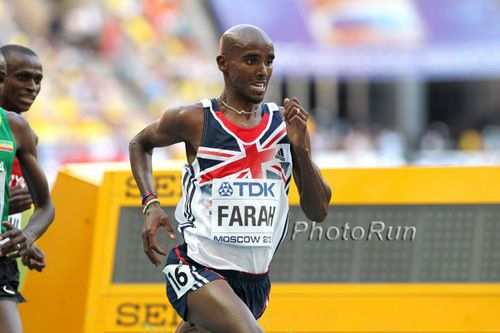A Strategy To Beat Mo Farah Not Yet Found
by Jusin Lagat
Some sports panelists at the Kenya Broadcasting Corporation (KBC) analyzing the 5000m runners just before they ran in the finals had recommended that the best way to beat Mo Farah was to set up a high pace from the beginning to the end of the race, to ensure that he runs out of strength before his last lap. It was the same thoughts that almost everyone I was able to chat with in person and on the social media had. But all that never worked to stop Mo Farah from winning another gold medal in the 14th edition of the IAAF World Championships event in Moscow. This happens just a year after he did another double win during the London Olympics.
Many Kenyans had hoped that Edwin Soi was going to pull out the same finishing kick he had used against Farah in June during the Prefontaine Classic Diamond meeting in Eugene, and win the championship title. But, things got different this time round. Either, Mo Farah had spend his time strategizing on how best to deal with Edwin Soi, or Soi himself was not in the same form he was in at the time he defeated Mo Farah. Looking at the way Mo Farah started trying to break away with 2 laps to go, I could not help but wonder whether that wasn’t a strategy to try and get the deadly kick out of Soi, of which he succeeded if it was.
Mo Farah did not relax at the back during the early stages of the race as he usually does. Kenya’s Isaiah Koech moved to the front and ensured that it was a fast pace and his compatriot, Thomas Longosiwa moved close to him as if to offer him some support. Edwin Soi was in the middle of the chasing group, but at some point after the 1,000m mark, that was crossed in 2:45.12, when the pace seemed to slow down a bit, he also moved to the front and did some pace setting before Muktar Edris of Ethiopia took over from him. It appeared as though the Ethiopians and the Kenyans all had one goal; to ensure a continuous fast pace.
The 2km mark was crossed in 5:38.11 as Mo Farah went to the front, but just momentarily before Isaiah Koech overtook him and continued to accelerate the pace leaving the rest of the athletes beginning to follow in a single file. They crossed 3km in 8:27.79 with Koech still on the lead. It appeared that is was hard to drop anyone from the pack because all of them, in that race, had made it there to the finals, signifying that they were all in their best forms.
With one kilometer to go, there was some rush from the athletes to the front and it was beginning to look almost crowded at the leading pack despite the pace getting hotter. Yenew Alamirew was leading with Mo Farah at the front as they crossed the 4km mark in 11:04.70.
It was as though the bell had already been rung as the athletes began sprinting with two more laps to go. It was Mo Farah making the move. Edwin Soi, who had for a considerable part of the race been strategically running behind Mo Farah seemed to have been taken by surprise by the turn of events happening earlier than he was anticipating. A big gap, and a number of athletes too, were already in between him and Farah as they all went for the last lap. Thomas Longosiwa and Koech fought hard to overtake Mo at the front, but the latter was able to hold on to the finish line in a time of 13:26.98. Hagos Gebhriwet of Ethiopia closed the gap on Isaiah Koech at the finish line as they both crossed it in 13:27.26, but the Ethiopian went away with the silver medal and Koech got the bronze.
My question after watching this race is whether Mo Farah is still going to double again at the Common Wealth Games next year in Scotland. But for now, much respect to him.





















